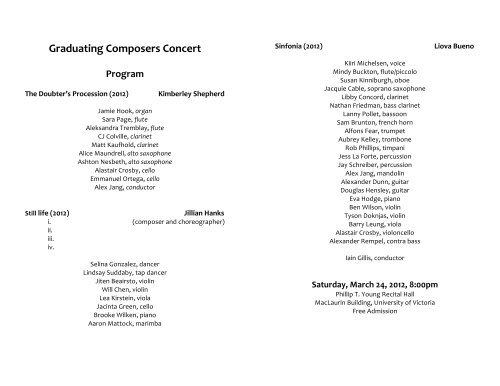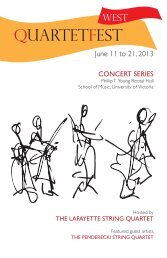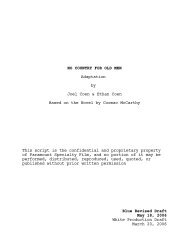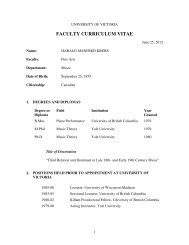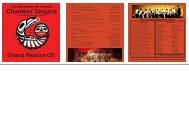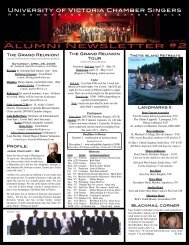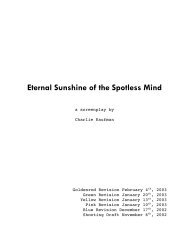Saturday, March 24 - University of Victoria Fine Arts
Saturday, March 24 - University of Victoria Fine Arts
Saturday, March 24 - University of Victoria Fine Arts
Create successful ePaper yourself
Turn your PDF publications into a flip-book with our unique Google optimized e-Paper software.
Graduating Composers Concert<br />
Program<br />
The Doubter’s Procession (2012) Kimberley Shepherd<br />
Jamie Hook, organ<br />
Sara Page, flute<br />
Aleksandra Tremblay, flute<br />
CJ Colville, clarinet<br />
Matt Kaufhold, clarinet<br />
Alice Maundrell, alto saxophone<br />
Ashton Nesbeth, alto saxophone<br />
Alastair Crosby, cello<br />
Emmanuel Ortega, cello<br />
Alex Jang, conductor<br />
Still life (2012) Jillian Hanks<br />
i. (composer and choreographer)<br />
ii.<br />
iii.<br />
iv.<br />
Selina Gonzalez, dancer<br />
Lindsay Suddaby, tap dancer<br />
Jiten Beairsto, violin<br />
Will Chen, violin<br />
Lea Kirstein, viola<br />
Jacinta Green, cello<br />
Brooke Wilken, piano<br />
Aaron Mattock, marimba<br />
Sinfonia (2012) Liova Bueno<br />
Kiiri Michelsen, voice<br />
Mindy Buckton, flute/piccolo<br />
Susan Kinniburgh, oboe<br />
Jacquie Cable, soprano saxophone<br />
Libby Concord, clarinet<br />
Nathan Friedman, bass clarinet<br />
Lanny Pollet, bassoon<br />
Sam Brunton, french horn<br />
Alfons Fear, trumpet<br />
Aubrey Kelley, trombone<br />
Rob Phillips, timpani<br />
Jess La Forte, percussion<br />
Jay Schreiber, percussion<br />
Alex Jang, mandolin<br />
Alexander Dunn, guitar<br />
Douglas Hensley, guitar<br />
Eva Hodge, piano<br />
Ben Wilson, violin<br />
Tyson Doknjas, violin<br />
Barry Leung, viola<br />
Alastair Crosby, violoncello<br />
Alexander Rempel, contra bass<br />
Iain Gillis, conductor<br />
<strong>Saturday</strong>, <strong>March</strong> <strong>24</strong>, 2012, 8:00pm<br />
Phillip T. Young Recital Hall<br />
MacLaurin Building, <strong>University</strong> <strong>of</strong> <strong>Victoria</strong><br />
Free Admission
Kimberley Shepherd is from the class <strong>of</strong> Pr<strong>of</strong>essor Christopher<br />
Butterfield and Dániel Péter Biró<br />
Jillian Hanks is from the class <strong>of</strong> Pr<strong>of</strong>essor John Celona<br />
These programmes are presented as part <strong>of</strong> the requirements<br />
for the Bachelor <strong>of</strong> Music in Composition program.<br />
Liova Bueno is from the class <strong>of</strong> Pr<strong>of</strong>essor John Celona<br />
This programme is presented as part <strong>of</strong> the requirements<br />
for the Master <strong>of</strong> Music in Composition program.<br />
Reception to follow in the Lounge.<br />
Still Life<br />
Program Notes<br />
Music and dance have always been a very big part <strong>of</strong> my life. I<br />
recently became interested in finding a way to fuse the two, and the<br />
result is this piece. My goal was to create a piece where the music is<br />
integral to the dance and the dance is integral to the music; one<br />
cannot exist without the other. The dance acts as a visual<br />
instrument, in conjunction with the heard musical instruments. Still<br />
life is a synthesis <strong>of</strong> the two things I love most.<br />
Sinfonia<br />
EQUIVOCACION DE LOS ANGELES<br />
-‐ Hector Inchaustegui Cabral (1912-‐1979)<br />
Eran ángeles fuertes,<br />
con las manos curtidas<br />
y dientes de caballo<br />
detrás de la sonrisa.<br />
Colgaron el Mal en una rama,<br />
y la tierra tirando,<br />
y la cuerda tirando,<br />
hicieron del mundo una sinfonía.<br />
Eran ángeles fuertes,<br />
abiertos los dedos de los pies,<br />
simples como el agua,<br />
rudos como el hierro.<br />
Potente músculos en el ala,<br />
la frente despejada,<br />
las manos, de ajusticiar,
sin resignación encallecidas.<br />
Eran dos iguales, quizás<br />
como si un limpio espejo<br />
entre ellos siempre retratara,<br />
eran dos y un pensamiento,<br />
dos gemelas llamas amarillas,<br />
una sola luz<br />
En donde tierra por morir se acaba<br />
detuvieron su paso poderoso;<br />
paro su canto la avecilla,<br />
expiraron los aires y perfumes.<br />
Eran fuertes...<br />
THE MISTAKEN ANGELS<br />
They were strong angels,<br />
with calloused hands<br />
and teeth like a horse<br />
behind their smiles.<br />
They hung Evil on a branch,<br />
and pushing the earth,<br />
plucking the string,<br />
from the world they made<br />
a symphony.<br />
They were strong angels<br />
with toes splayed,<br />
they were simple as water,<br />
rough as iron.<br />
With powerful muscles in their wings,<br />
unclouded brows,<br />
executioner's hands,<br />
hard and remorseless.<br />
They were two equals,<br />
Almost as if a lucent mirror<br />
between them were to reflect each the other,<br />
two contained in one thought,<br />
twin yellow flames,<br />
a single light.<br />
In the end, in a land worth dying for,<br />
they halted their heavy step;<br />
the little bird stopped its song,<br />
and from them wafted<br />
a perfumed breeze.<br />
They were strong...<br />
Translated by: Kiiri Michelsen<br />
The sinfonia de camara (“chamber symphony”) is a comparatively new genre:<br />
the precedent and still most-performed example in the international repertory<br />
is Arnold Schoenberg’s Kammersymphonie, op. 9 (1906). The genre’s nonprogrammatic<br />
title has predominantly indicated a reduction <strong>of</strong> the performing<br />
forces that are associated with the symphony <strong>of</strong> that genre’s recognized<br />
masters – among them Mozart, Beethoven, Brahms, Franck, Mahler, Nielsen,<br />
and Shostakovich – without any corresponding diminution <strong>of</strong> the aesthetic<br />
aims <strong>of</strong> the work. It is this serious-mindedness that sets the “chamber<br />
symphony” apart from the more casual “sinfonietta.”<br />
Liova consistently and graciously acknowledges his musical predecessors and<br />
philosophical influences. The Sinfonía is his respectful and critical response to<br />
the history <strong>of</strong> the symphony that we have inherited today. It is at once openly<br />
traditional and emphatically modern. We hope that this performance may be<br />
an audible reminder that traditional and modern modes <strong>of</strong> thought are not<br />
mutually antagonistic.<br />
Rather, when tempered by passion, intellect, industry, and humility, the<br />
traditional and the modern stand in a relationship <strong>of</strong> dynamic equilibrium<br />
whose flexibility and generative power is considerable.<br />
To speak in terms <strong>of</strong> architecture, the Sinfonía is a stabilized and smooth<br />
mixture <strong>of</strong> 1) sonata form, 2) cyclical form, and 3) the madrigal. The principal<br />
form is governed by a neoclassical sonata design: changes in tempo, texture,
and orchestration delineate the various sections – akin to movements in a<br />
standard symphony – <strong>of</strong> this single-movement work. The first theme, spun out<br />
immediately from the downbeat in the strings, piano, and treble winds results<br />
from the elaboration <strong>of</strong> a three-note cell. The contrasting second theme is first<br />
presented by bassoon, trombone, and cello in unison. The tam-tam (large<br />
gong) marks the end <strong>of</strong> the exposition proper: this is only a subsection <strong>of</strong><br />
three-section (=movement) design. The sonata’s lengthy development begins<br />
with a dense working out <strong>of</strong> the first theme, first by (rhythmic) diminution in<br />
the winds, then by (metrical) augmentation in the strings. A rapid staccato<br />
figure in the brass is first introduced just before the transition between those<br />
processes. A polyrhythmic tutti ensues: the metre rapidly contracts toward<br />
silence through an ultra-compact, homorhythmic codetta for brass and pitched<br />
percussion to bring the first section to a close.<br />
The slow, second section (=movement) <strong>of</strong> the sonata form – a continuation <strong>of</strong><br />
the development – is introduced by harmonics in the guitars. The components<br />
<strong>of</strong> the second theme are added to the developmental crucible in the brief<br />
passage that prepares the entrance <strong>of</strong> the human voice, that primordial matter<br />
<strong>of</strong> Liova’s craft (and even <strong>of</strong> Music and <strong>of</strong> human communication, I would<br />
argue). A translation <strong>of</strong> the text, by the Dominican writer Hector Inchaustegui<br />
Cabral (1912-1979), is provided. The first line <strong>of</strong> the poem is treated to<br />
considerable repetition and elision; the madrigalian influence may be heard<br />
already in the way the guitar parts are now closely imitative, now become one.<br />
When the poem is allowed its autonomy, the music proceeds to a new<br />
subsection.<br />
Rhythmic ostinatos are wedged between the barlines by the congos (in 2/4)<br />
and guitars (variously in 2/4, 3/4, or 6/8). A free development <strong>of</strong> the first<br />
theme, introduced by bass clarinet, accompanies a vocalise that is inserted<br />
between before the last line <strong>of</strong> the poem’s second stanza. As the words give<br />
way to pure tones, the vernacular rhythms break down the regular metre. The<br />
ostinatos are subjected to their own brief development (by fragmentation),<br />
then are re-introduced, whole once again, in reverse order. A developmental<br />
recitation <strong>of</strong> the poem (“tirando”) has its madrigalian counterpart in the rapid<br />
passage work <strong>of</strong> contracting expanding tuplets in the upper winds. A brief<br />
caesura prepares the way for the codetta to the development comprising an<br />
oblique wedge between Scotch-snap winds and <strong>of</strong>f-beat guitar arpeggios,<br />
unpitched percussion, and low strings.<br />
The guitar harmonics return to signal the rounding <strong>of</strong>f <strong>of</strong> the ternary (ABA′)<br />
slow section in particularly elegant fashion: a short accompanied invention à 3<br />
leads seamlessly into a brief 7-part canon on a subject derived from the first<br />
theme. This miniature binary pair, itself a delicate study in instrumental<br />
timbre, also functions as a retransition to the recapitulation in the overarching<br />
sonata form.<br />
The recapitulation, true to “sonata logic” (sonata form is more a mode <strong>of</strong><br />
musical thought than it is a form in the sense <strong>of</strong> a mold to be filled) resolves<br />
and sublimates the musical problems <strong>of</strong> what has gone before. The three<br />
discrete sections <strong>of</strong> this one-movement sonata form and the three parts <strong>of</strong><br />
sonata form (exposition – development – recapitulation) are once again re-<br />
aligned. The first and second themes return in their original order: they are<br />
immediately identifiable, but they are changed as a direct result <strong>of</strong> the<br />
proceedings <strong>of</strong> the lengthy development. The ostinatos return, but effect new<br />
ostinatos <strong>of</strong> different rhythmic configurations and on new instruments. The<br />
asymmetrical meters <strong>of</strong> the exposition and development do not return. The<br />
basic materials <strong>of</strong> the two codettas are combined to form a short coda to the<br />
Sinfonía, a study in diaphanous orchestration and economy <strong>of</strong> means.<br />
Iain S. Gillis<br />
<strong>Victoria</strong>, BC<br />
<strong>March</strong> 2012


